Japanese manufacturing and SMB
|
Cat: Eco. |
|
Motonari Yamada |
07y29u/18123r |
Title
Japanese Manufacturing and SMB
日本のモノづくりと中小企業
Index
- Theme:
- Value creation and profit capture:
- Finished product manufacturer vs. Parts manufacturer in electronics industry:
- Finished product manufacturer vs. Parts manufacturer in automobile industry:
- Difficulty in making profit by manufacturing:
- New paradigm of management:
- Strategic viewpoint to continue manufacturing:
- From customized to modular production:
Why?
- Manufacturing, or monozukuri of Japan has been regarded as worldwide most competitive industry. In particular, the most spirited area of manufacturing is Nagoya, Chubu area, symbolized by automobile and auto parts industries.
- On Nov. 29, 2007, there was a unique presentation at the event of Techno Frontier 2007in Nagoya, by Motonari Yamada, associate professor of Nagoya Univ., whose title was "Japanese manufacturing and Small-Medium Business."
- It gave me very suggestive answers about how the competitiveness in the manufacturing industry in Japan has changed during last decades.
- 日本のモノづくりは、世界でも最も競争力おある産業とみられてきた。特に、最も活発なのは、自動車や自動車部品に象徴される中部地区である。
- 2007/11/27に名古屋でのテクノフロンティア2007の会場で名古屋大学山田基成准教授によるユニークな講演があった。その表題は「日本のモノづくりと中小企業」であった。
- この講演では、日本が製造業が過去数十年の間でどのように競争力の変遷があったのかについての非常に示唆に富む回答が得られた。
Key
phrase
キーフレーズ
>Top
0. Theme:
- Management of technology:
- How to utilize technology to establish business model.
- How to concentrate corporate resources at the optimized mix of corporate strategy and core technology.
0.
テーマ:
- 技術のマネジメント:
- 事業モデルを構築する上で、技術力をどう活かすか。
- 市場ニーズの中で、戦略的な視点とコア技術の組み合わせを見つけ、経営資源を集中する。
>Top
1. Value creation and profit capture:
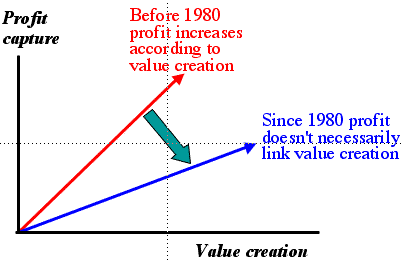 Value creation: to create value for customers through developing technology and/or products.
Value creation: to create value for customers through developing technology and/or products. - Profit capture: to gain profit by the corporation from the above value creation.
- Japan had been regarded in making 'value creation': using high technology and developing products with valuable functions and available convenience, as well as accomplishing quality, cost, and delivery by its efficient and effective management.
- Share of shipment value of 'Electric machine' vs. 'Transport machine' in Japan:
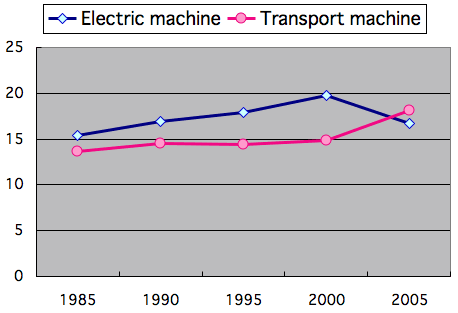 These two items have about 1/3 shares in total industrial production.
These two items have about 1/3 shares in total industrial production.- Since 2005, transport machine became No.1 production.
- Japanese manufactures are still skillful at value creation, which recently doesn't guarantee profit capture any more.
- More strategic way of thinking or management is urged to secure the corresponding profit rather than to develop and produce excellent product or service at lower cost.
1.
価値創造と利益獲得:
- 価値創造:技術・製品開発により、顧客に提供する価値を創り出すこと
- 利益獲得:その顧客価値を企業の利益獲得に結びつけること
- 日本企業は価値創造は得意であり、機能や利便性など価値の高い技術・製品を開発し、そのオペレーションを効率的・効果的に勧めるマネジメントにより、品質・コスト・納期を達成してきた。
- 日本企業は依然として、価値創造は得意だが、現在では利益獲得は自然にもたらされてはいない。
- 利益を上げるためには、優れた製品サービスを低コストで開発製造するだけでなく、戦略的思考やマネジメントが必要。
>Top 2. Finished product manufacturer vs. Parts manufacturer in electronics industry:
- Finished product manufactures in Japan: 10 companies
- Hitachi, Toshiba, Matsushita, Sony, Fujitsu, Sharp, NEC, Mitsubishi Electric, Pioneeer, Sanyo
- Parts manufactures in Japan: 12 companies, including machinery equipment and material
- Kyocera, TDK, Alps Electric, Nitto Denko, Rohm,
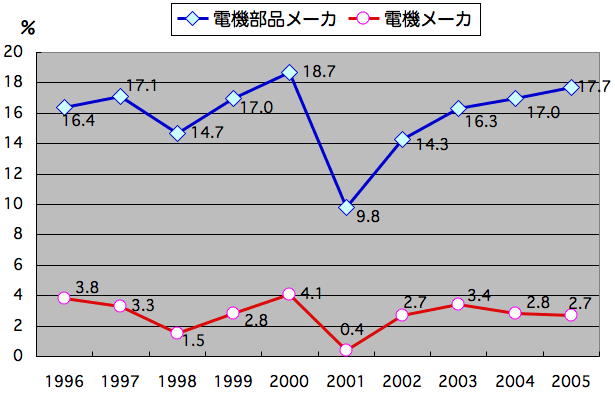 Murata Manufacturing, Nidec, Hirose Electric, Ibiden, Advantest, Nippon Electric Glass
Murata Manufacturing, Nidec, Hirose Electric, Ibiden, Advantest, Nippon Electric Glass
------------
- Sales profit ratio of electric manufacturer and electric parts manufacturer:
- Depression of IT industry in 2001
- marterial manufacturers are more profitable than all-round electric manufacturers.
- Cf: Here, profit is operation profit.
------------
------------
------------
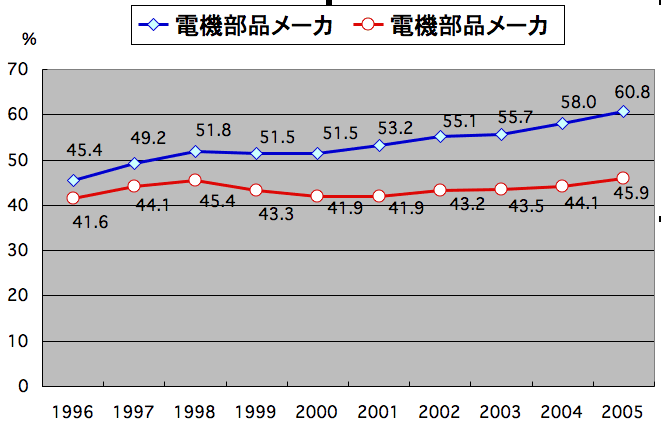 Overseas sales ration of electric manufacturer and electric parts manufacturer:
Overseas sales ration of electric manufacturer and electric parts manufacturer:
- Overseas sales ratio of electric manufacturers are between 41 and 46%, while electric parts manufacturers are
steadlly increasing.
- Moreover, nearly half of the sales of parts manufacturer are exported as embeded parts.
2.
完成品メーカと部品メーカ (エレクトロニクス産業) :
- 完成品メーカ:(10社)
- 日立、東芝、松下、ソニー、富士通、シャープ、NEC、三菱電機、パイオニア、三洋電機
- 部品メーカ: (12社、機械設備・素材を含む)
- 京セラ、TDK、アルプス電気、日東電工、ローム、村田製作所、日本電産、東京エレクトロン、ヒロセ電機、イビデン、アドバンテスト、日本電気硝子
------------
- 電機メーカと電機部品メーカの売上営業利益率 <左図>
- 部品メーカの方が利益率は高い
------------
- 電機メーカと電機部品メーカの海外売上比率 <左図>
- 海外売上比率は、電機部品メーカは確実に比率を上げている。
- さらに、電機部品メーカの売上の約半分は、電機メーカの製品に組み込まれて輸出される
>Top 3. Finished product manufacturer vs. Parts manufacturer in automobile industry:
- Automobile industry in Japan: 7 companies
- Toyota, Nissan, Honda, Mitsubishi Motors, Mazda, Fuji Heavy Industries, Suzuki Motor
- Automobile parts industry in Japan: 19 companies
- Denso: powertrain, car air conditioner, radiator
- Aishin Seiki: drivetrain, body, brake & chassis, engine
- Tokai Rika: car security/safety system
- Toyoda Gosei: instrument panel module & components
- Koito Manufacturing: headlamps, signaling lamps
- Calsonic Kansei: cockpit module, air conditioning system
- Exedy Corp: manual transmission, automatic torque converter
- Yorozu: suspension
- Tachi-S: car seat
- Unipress: transmission parts
- Showa: shock absorber, power steering, differential gear
- Musashi Seimitsu Industry: camshaft & balance shaft, gear, ball joint
- Eftec: pulse generator
- Keihin: fuel injector, throttle body
- Akebono brake: disc brake, drum brake
- Stanley Electric: headlamp, rear combination lamp
- Bridgestone: tire
- NHK Spring: wire spring, flat spring
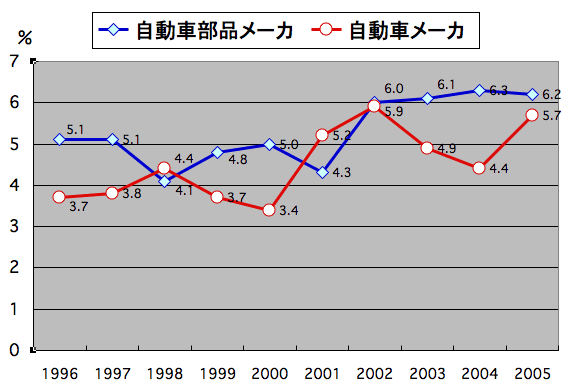
- NTN: bearing
------------
- Sales profit ratio of automobile manufacturer and automotive parts manufacturer:
- Profit ratio of both automobile manufacturers and automotive parts manufactures are high:
- Cf: Here, profit is operation profit.
------------
------------
------------
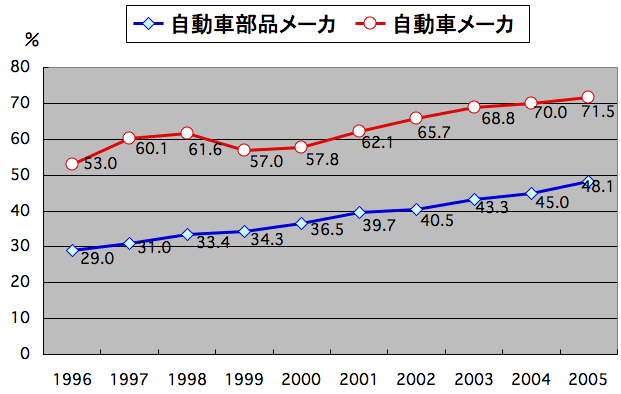 Overseas sales ration of automobile manufacturer and automotive parts manufacturer:
Overseas sales ration of automobile manufacturer and automotive parts manufacturer:
- Export ratio of both automobile manufactures and automotive parts manufactures have proceeded particularly in the last decade:
- Moreover, nearly 2/3 of the parts manufactures are exported as the embedded parts.
- Therefore, the export ratio of both is more or less similar in both manufacturers.
------------
- Comment: manufactures with higher export ration are more competitive, showing more profit.
3.
完成品メーカと部品メーカ (自動車産業) :
- 自動車メーカ:(7社)
- トヨタ、日産、ホンダ、三菱、マツダ、富士重工、スズキ
- 自動車部品メーカ:(19社)
- デンソー:パワートレイン、カーエアコン、ラジエータ
- アイシン精機:ドライブトレイン、ボディ、ブレーキ&シャシ、エンジン
- 東海理化:カーセキュリティー/セイフティシステム
- 豊田合成:インスツルメントパネル・モジュール構成部品
- 小糸製作所:ヘッドランプ、標識灯
- カルソニックカンセイ:コックピットモジュール、エアコンシステム
- エクセディ:マニュアルクラッチ、オートマチック・トルクコンバータ
- ヨロズ:サスペンション
- タチエス:自動車用シート
- ユニプレス:トランスミッションパーツ
- ショーワ:ショックアブソーバ、パワーステアリング、デファレンシャルギヤ
- 武蔵精密:カムシャフト&バランスシャフト、ギア、ボールジョイント
- エフテック:モータ制御用パルスジェネレータ
- ケーヒン:フュエルインジェクター、スロットルボディ
- 曙ブレーキ:ディスクブレーキ、ドラムブレーキ
- スタンレー電気:ヘッドランプ、リアコンビネーションランプ
- ブリジストン:タイヤ
- ニッパツ:コイルバネ、板バネ
- NTN:ベアリング
------------
- 自動車メーカと自動車部品メーカの売上営業利益率 <左図>
- 自動車メーカおよび自動車部品メーカいずれも利益率は高い。
------------
- 自動車メーカと自動車部品メーカの海外売上比率 <左図>
- 海外売上比率は、自動車メーカおよび自動車部品メーカいずれも、この十年に確実に輸出比率を上げている。
- さらに、自動車部品メーカの売上の約2/3は、自動車の部品として組み込まれて輸出されるので、双方とも同程度の輸出比率と言える。
- コメント:輸出比率の高いメーカは国際競争力があり、より高い利益率を示す。
>Top 4. Difficulty in making profit by manufacturing:
- Single-year profit in 3 years and cumulative profit in 5 years (Model):
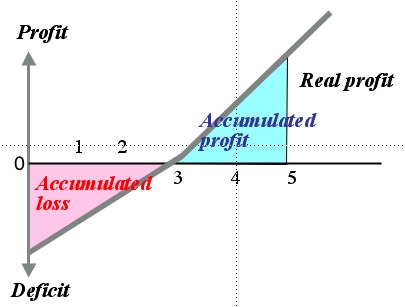
------------- Life-cycle of hit products:
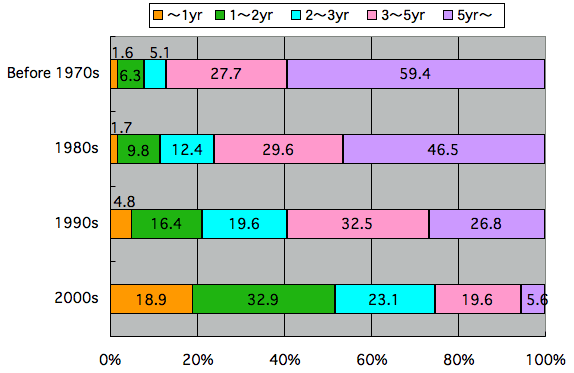 However, the market is getting ephemeral: good sale by hit products is short-lived.
However, the market is getting ephemeral: good sale by hit products is short-lived.
- Many business tends to be fashion business:
- Apparel and cosmetics are seasonal goods (for spring, summer, and autumn-winter use). Now PC and mobile telephone have become similar, brings fashionable new models every season to the market.
- Thus, new model of PC will fall prices in two months after the new release. Technical advantages can maintain only for about two months, urging quick return of fund within such short period.
4. モノづくり利益の困難性:
- 技術革新・ビジネスのスピードを競う時代:
- 投資と市場のタイムスパンのアンバランス
------------
- 3年単年度黒字、5年累積赤字一掃モデル: <左図>
------------
- ヒット商品のライフサイクル:<左図>
市場はヒット商品の売れ行き期間の短命化が顕著
- 多くのビジネスがファッションビジネス化している。
- 衣料や化粧品は季節商品(春、夏、秋冬用)。今やPCも携帯も同様になり、季節毎に新商品を市場投入している。
- PCの新モデルは新発売後2ヶ月で値崩を起こす。技術的優位はほぼ2ヶ月した維持できず、その短期間に資金回収を迫られる。
>Top 5. New paradigm of management:
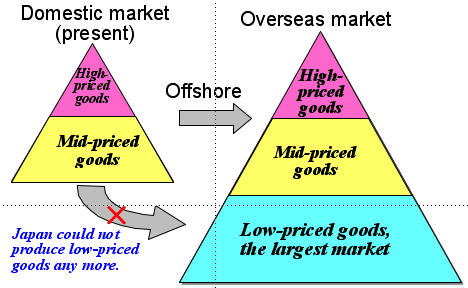 The position of present Japanese manufactures:
The position of present Japanese manufactures:
- Once in 20C Japan has entered overseas advanced market with low-priced goods. But during decades of competition, Japanese manufacturers have shifted their production line to mid or high-priced goods; Japan has no capacity of competitive production of lower-priced goods, which have been replaced by once Korean, now mostly by Chinese competitors.
- But there are still bigger market of low-priced goods worldwide; eg. mobile phone market Japanese manufactures could not supply low-priced terminals.
- Comment: This is a kind of "overshoot" phenomenon, which outpaces the required quality level of major customers.
5.
マネジメントの新しいパラダイム:
- 現在の日本メーカのポジション: <左図>
- かつて20世紀の日本は海外の先進市場に低価格製品で参入した。しかし数十年間の競争の結果、日本メーカの生産ラインは、中〜高価格製品にシフトしてしまい、もはや競争力のある低価格品を生産できなくなった。その部分はかつては韓国に、現在はほとんど中国に取って代わられている。
- しかし、世界には低価格品の大規模な市場が存在する。例:携帯電話市場では、日本メーカは低価格端末を提供できない。
- コメント:
これはある種の「オーバーシュート現象」である。即ち主要な顧客の品質要求レベルを追い越してしまったのである。
>Top 6. Strategic viewpoint to continue manufacturing:
- Strategic viewpoint:
- Agile management:
to purse focused agility as the organization
- Conversion of 3M (Materials, Machines, and Men):
to convert personal skills to organizational capacity
- Pursue of global niche market:
to shift competitive edge due to modularization
- Realization of architecture innovation:
to create new market
- Establishment of new collaboration among corporations:
to find profitable business models
------------
- How to respond to agility:
- To decide change of the industrial clock (rhythm of changes) by oneself: able to control
- To adjust oneself to the rhythm: able to respond quickly
- To act ex post facto: to delay
6. モノ造りを継続するための戦略的視点:
- 戦略的視点:
- 経営スピードの実現:
組織として探求するスピードの焦点化
- モノづくりの基盤としての素材・機械・人材の融合:
個人スキルの組織能力への転換
- グローバルニッチ市場の探求:
モジュール化に伴う優位性の移動
- アーキテクチャ・イノベーションの実現:
新たな市場の創造
- 新たな企業間連携の構築:
利益を上げる事業の仕組み作り
------------
- スピードへの対応方法:
- 業界時計(変化のリズム)を自ら決める:コントロールできる
- に自らを合わせる:迅速に対応する
- に事後的に対応する:遅れる
>Top 7. From customized to modular production:
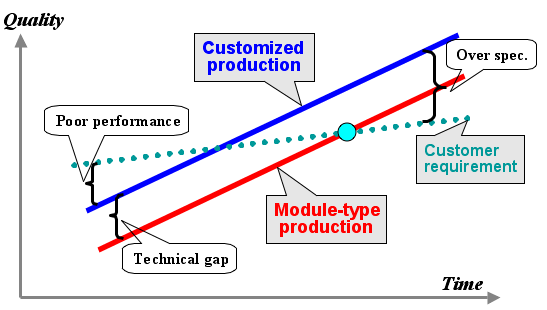 Customized production vs. Modular-type production:
Customized production vs. Modular-type production:
- There is over specification by customized production compared to the expected requirement of customer.
- Modular-type production is generally inferior to customized production, but the former can minimize the over specification.
- Thus modular-type production can maintain price competitiveness for longer time.
7. 摺り合わせからモジュール型への変化:
- カスタマイズ生産とモジュール型生産比較:<左図>
- カズタマイズ生産は顧客の期待する要求より性能過剰が生じる
- モジュール型生産は一般的にカスタマイズ生産より性能は劣るが、前者は過剰スペックを最小化できる。
→より長期化価格競争力を維持できる。
Comment
- In software industry, over specification or over shoot phenomenon is a controversial issue; SasS (Software as a Service) seems a typical challenge to modular-type software production, or even more.
- Because SaaS is aiming to abandon ownership of software but use of it.
- Why not pursue AaaS (Automobile as a Service) in 21C, pursuing use of cars instead of owning it.
- ソフトウェア業界では、過剰仕様、つまりオーバーシュート現象は大きな論争となっている。SaaS (Software as a Service) はモジュールタイプの生産への典型的なチャレンジである。
- なぜならSaaSはソフトウェアを所有することをやめて、それを利用することを目指しているからだ。
- 21世紀には、自動車も同様にもはや所有することではなく、AaaS (Automobile as a Service)を目指すべきではないか。
Title |
Japanese Manufacturing and SMB |
日本のモノづくりと中小企業 |
|---|---|---|
Index |
|
|
Why? |
|
|
Key phrase |
キーフレーズ |
>Top 0. Theme:
|
0. テーマ:
|
>Top 1. Value creation and profit capture:
|
1. 価値創造と利益獲得:
|
>Top 2. Finished product manufacturer vs. Parts manufacturer in electronics industry:
|
2. 完成品メーカと部品メーカ (エレクトロニクス産業) :
|
>Top 3. Finished product manufacturer vs. Parts manufacturer in automobile industry:
|
3. 完成品メーカと部品メーカ (自動車産業) :
|
>Top 4. Difficulty in making profit by manufacturing:
|
4. モノづくり利益の困難性:
|
>Top 5. New paradigm of management:
|
5. マネジメントの新しいパラダイム:
|
>Top 6. Strategic viewpoint to continue manufacturing:
|
6. モノ造りを継続するための戦略的視点:
|
>Top 7. From customized to modular production:
|
7. 摺り合わせからモジュール型への変化:
|
Comment |
|
|